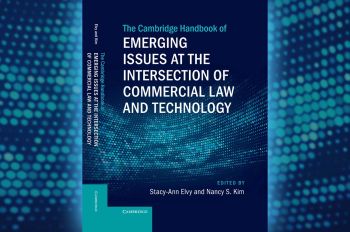Chance Encounter Leads Applied Math Student to Award-Winning Research Collaboration

A chance encounter at an academic conference initiated a new research collaboration, a grant award, opportunities to learn from academics across the globe—and an Interdisciplinary Opportunity Award from the Center for Multiscale Cell Fate Research for an Illinois Institute of Technology student and his team.
Min-Jhe Lu (Ph.D. AMAT 3rd Year) was presenting his research on solid tumor carcinomas at a poster session when the student presenting next him, Yifan Wang from the University of California, Berkeley, commented on Lu’s work and asked if he would be interested in collaborating with him.
“We sat down at dinner and talked about ideas,” Lu says. “We built a proposal based on our model in cancer research.”
It was Wang who suggested the pair apply for the Interdisciplinary Opportunity Award through the National Science Foundation’s Center for Multiscale Cell Fate Research at the University of California, Irvine. However, they needed a UC Irvine student as part of the team to qualify.
They invited Yuchi Qiu to join them and furiously assembled a proposal the next day in order to meet the deadline.
They based the proposal on Lu’s model examining the transgenic mutation of normal cells into solid tumor carcinomas. Wang’s background in fluid dynamics helped in examining the elasticity of the surrounding tissue, and Qiu’s experience in biology assisted in guiding the overall project.
“All three of us study in our math departments at our schools,” Lu says. “But we’re all from a different background, which leads to the interdisciplinary aspect of the research.”
The project has involved a lot of long-distance collaboration. Not only are Lu’s partners at different universities in California, but his advisers, Professor of Applied Mathematics Chun Liu and Associate Professor of Applied Mathematics Shuwang Li, also set up weekly online seminars allowing Lu and his team to present their work to academics from across the globe and to receive feedback from mathematicians with a wide variety of expertise.
“Indeed the online platform has created many more opportunities,” Liu says. “Currently we have several online seminars with various subjects. These seminars have speakers and participants from all over the world, including Europe and Asia.
“The seminars are open to everyone, but it’s Ph.D. students like Min-Jhe who benefit the most,” Liu continues.
The online platform proved useful again as Lu and his team presented preliminary results at the Early Career Symposium hosted by the Center for Multiscale Cell Fate Research on May 8. The symposium included other Ph.D. students and postdoctoral fellows who earned the Interdisciplinary Opportunities Award.
Lu’s model can be applied to any solid tumor carcinoma. This year’s research will not only examine the genetic mutation from normal tissue to cancerous tissue, but also the angiogenesis stage of tumor growth, or how blood vessels form around the tumor to provide the enormous nutrient supply it needs to grow. This process also affects the nutrient supply to healthy tissue surrounding the tumor.
“To trigger angiogenesis, we need to consider necrosis, which is like a tomb in the center of the tumor tissue,” Lu says. “Because the tumor grows very large, the nutrients cannot be fused into the center of the tumor tissue, so it begins to die.”
Lu plans to travel to UC Irvine and present results of the team’s work at the Center for Multiscale Cell Fate Research Annual Conference in the fall.
Illustration: Illinois Tech student Min-Jhe Lu (Ph.D. AMAT 3rd Year) is pictured (David Ettinger)




